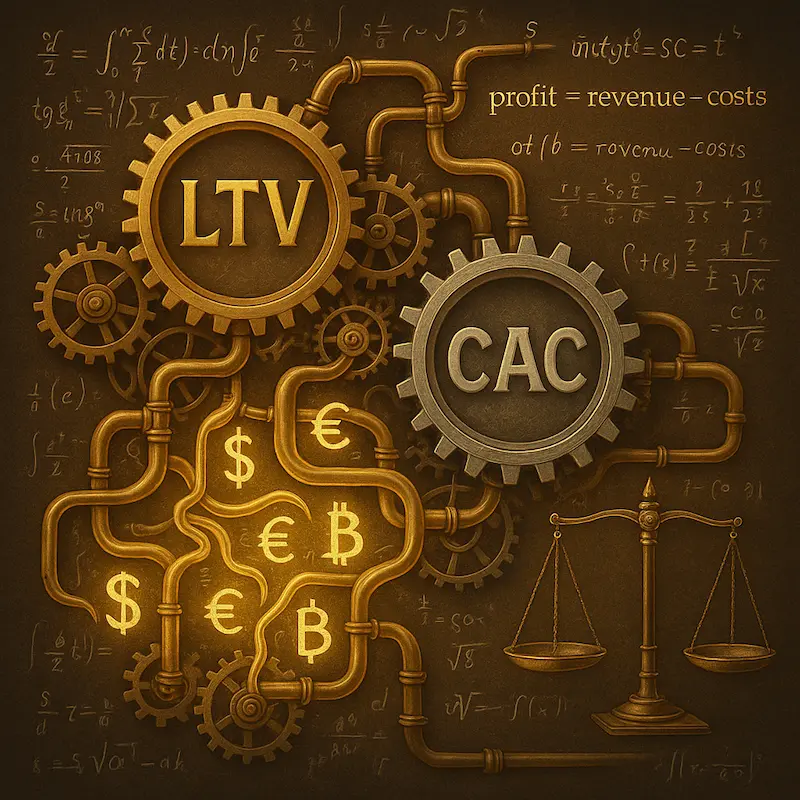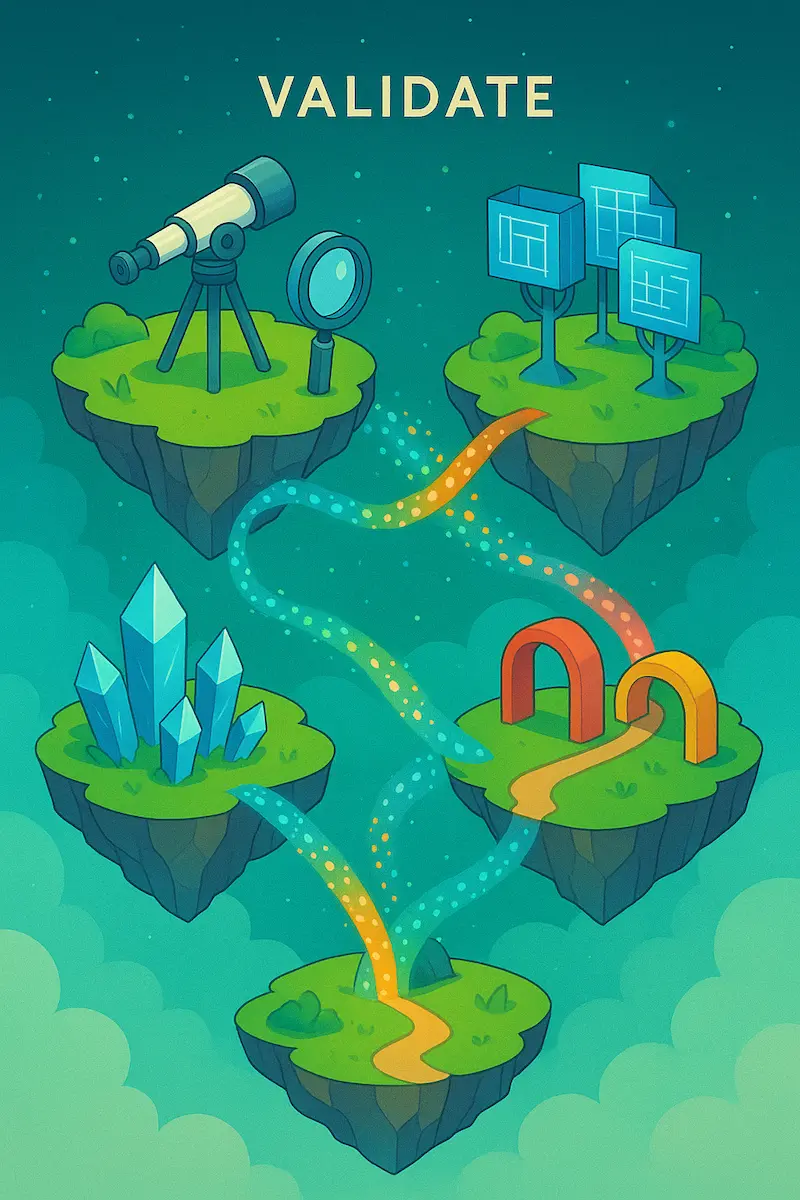Table of Contents
- 1. The Lean Test: Why Financial Validation Comes First 🧠
- 2. Build, Price, Learn: Designing MVPs That Pay for Themselves 🧱
- 3. Pre-Sales, Not Pipe Dreams: Real Revenue as Real Proof 💵
- 4. Unit Economics 101: Can You Make Money at Scale 📊
- 5. Early Signals: When to Refine Before Scaling🕵️
- 6. Tools of the Trade: Testing Assumptions Without Burning Cash 🧰
- 7. 🔁 Turning Customer Feedback into Revenue Insights
- 8. 🎯 EIM's Framework for Financial Validation
- 9. ✅ Final Take: Validation Is a Milestone, Not a Mood
- 10. Book a Free Consultation
- 11. FAQ's
The Lean Test: Why Financial Validation Comes First 🧠
Traditional market research tells you what people say they want. Financial validation reveals what they are willing to pay for. It reveals the difference between "I would buy this" and clicking the purchase button.
Financial validation is your startup's reality check. It forces uncomfortable questions early: Is your pricing wishful thinking? Are you solving a problem that people will pay to have fixed? Can you acquire customers at a reasonable cost?
Successful founders validate financially before technically. They prove people will pay before perfecting the product. This approach isn't just smarter; it's financially strategic.
Instead of spending months building features, you spend days testing willingness to pay. Instead of burning cash on assumptions, you generate revenue while learning.
Most founders build first, then hope someone will pay. Successful founders focus on getting payment commitments or promises before building anything substantial. This de-risks the venture and provides ultimate proof: actual money changing hands.

Build, Price, Learn: Designing MVPs That Pay for Themselves 🧱
The traditional MVP (Minimum Viable Product) approach often prioritizes building first and monetizing later. But what if your MVP could fund itself while you learn?
Self-funding MVPs start with a simple principle: charge before you build. This proves value exists before you invest time and money creating it.
Consider the landing page MVP. Create a compelling description of your solution, set up payment, and drive targeted traffic. When people convert and pay, you've validated demand and pricing. When they don't, you've saved months of development.
The service MVP is another approach. Instead of building software, deliver the service manually. A project management tool becomes personal consulting. An automated marketing platform becomes a hands-on service.
This works because it removes the biggest startup risk - building something nobody wants. By charging first, you force customers to put skin in the game. They're betting their money on it, not just saying they like it.
Be transparent about what you're delivering. Pre-orders work when customers understand they're backing a future product. Service-based MVPs work when you're clear about manual delivery.
Pre-Sales, Not Pipe Dreams: Real Revenue as Real Proof 💵
Pre-sales are startup validation gold: they prove demand, generate cash flow, and fund development, all at once. But here’s the catch: too many founders sell a perfect future instead of a valuable present.
Successful pre-sales focus on the problem, not the solution. You're selling outcomes and transformation, not features and perfect software.
Psychology is powerful. When someone pays for something that doesn't exist yet, they're voting confidence in both your solution and your ability to deliver. That's stronger than any survey or focus group.
Timing matters. Launch too early, and you'll struggle to articulate value. Too late, you missed funding development. The sweet spot: communicate the problem and solution before building the final product.
Many successful founders use significant early-bird discounts - 30-50% off future pricing, to incentivize early commitment while generating meaningful revenue.
Unit Economics 101: Can You Make Money at Scale 📊
Unit economics are the line between momentum and sustainability. You might have demand, pre-sales, and even early revenue, but if the math doesn’t work, the model won’t scale
The equation: Customer Lifetime Value (LTV) minus Customer Acquisition Cost (CAC) equals profit per customer. Most founders get the details wrong.
CAC isn't just advertising spend. It includes sales salaries, marketing tools, content creation, and any acquisition-related costs. Many founders calculate CAC based on direct advertising costs and wonder why unit economics fall apart at scale.
LTV can feel confusing at first, but it’s one of the most important numbers in your business. To calculate it, you need to think about how long a customer stays, how much they pay, and how much it costs to serve them. For example, if a customer pays $100 per month and costs $80 to serve, you’re making $20 in profit each month. Multiply that by how long they stick around, and you have their Lifetime Value. Then subtract your acquisition costs
The golden rule: 3:1 LTV to CAC ratio with payback in 12 months or less. This provides margin for unexpected costs and reasonable growth rates. Below 3:1 makes scaling dangerous.
Startups often optimize for vanity metrics instead of unit economics. Growing monthly active users feels good, but growing profit per customer pays the bills. Proper financial tracking ensures you measure what matters.

Early Signals: When to Refine Before Scaling🕵️
Once you begin receiving payments or pre-selling, watch for patterns. Some confirm expectations, others challenge them. Early signals are invitations to refine before expanding.
If people engage but drop off at payment, your pricing might need a second look. If acquisition costs keep rising but conversions stay flat, your message might not be landing. These aren’t red flags. They’re signals. A few smart tweaks could turn curiosity into commitment.
Key validation metrics:
Conversion rates at each funnel stage
Time from first contact to purchase
Repeat purchase rates and frequency
Support ticket volume and type
Refining early helps you protect your resources. It keeps you from scaling models that look promising on paper but can’t support real, sustained growth. Try testing pricing, customer segments, or delivery methods in small, controlled batches before going all in.
Teams treating validation as an ongoing discipline build more adaptable companies. They constantly tune based on market feedback, replacing rigidity with responsiveness.
Tools of the Trade: Testing Assumptions Without Burning Cash 🧰
Financial validation doesn't need expensive tech. Effective early tests rely on fast, flexible, low-cost tools. What matters is testing assumptions one at a time.
You don’t need a finished product to start testing. A simple landing page can validate demand in hours. Collect payments, gauge interest, and gather feedback before writing a single line of code. For acquisition testing, a small budget spent on targeted traffic can reveal whether your message resonates. Track how people engage, where they click, and where they drop off. If you’re testing a service model, offer it manually at first. Use booking forms, direct communication, and simple delivery methods to create a real experience before investing in automation. The goal is to simulate the core value, not the final form, and learn as fast as possible.
Budget breakdown:
Landing page: $0-50
Payment processing: $0-30/month
Analytics: $0-100/month
Ad testing: $200-500
Email automation: $0-50/month
Isolate one question at a time: Will they pay this price? Will they convert from this message? Each experiment provides sharper insights into value drivers and friction points.

🔁 Turning Customer Feedback into Revenue Insights
Validation isn't only about purchases, it's about what customers say, ask for, and hesitate to do. Feedback becomes powerful when tied to behavior. If someone says your product is great but doesn't buy, that's a gap worth exploring.
Build listening moments into your process. Ask open-ended questions during onboarding or post-purchase. Follow up with people who didn't complete checkout. Interview prospects who dropped off after expressing interest.
Valuable insights come from hesitation. When customers pause or ask for clarification, they're revealing where your model might underserve them.
Common feedback patterns:
"It's too expensive" = pricing or value communication issues
"I need to think about it" = insufficient urgency or unclear benefits
"Do you have X feature?" = potential expansion revenue
"This is confusing" = onboarding friction affecting conversion
Pay attention to consistent requests, especially from paying customers. Multiple users asking for the same feature or pricing structure preview how the product could evolve.
Filter feedback through behavior. If someone asks for a feature but wouldn't pay more for it, it may not be worth building.

🎯 EIM's Framework for Financial Validation
At EIM, we guide founders through validation as structured learning. The goal isn't just proving something once, but building a habit of testing that continues as the business grows. Our framework includes four simple checkpoints:
Step 1: Identify one core assumption to test. Is it about pricing, delivery, audience, or conversion? Be specific. Don't try validating everything at once. Pick the assumption that, if wrong, would kill your business model.
Step 2: Design a lightweight experiment. Use tools that simulate or simplify the experience. Build only what's necessary to trigger the behavior you want to observe. Remember, the goal is learning, not launching.
Step 3: Measure the financial signal. Focus on what people do, not just what they say. Track payment, opt-ins, or other real commitments. Revenue is the ultimate validation metric because it represents actual value exchange.
Step 4: Use the result to make a decision. Refine, double down, or pivot based on what the test reveals. Don't get emotionally attached to any single approach. Let the data guide your next move.
This loop can run for days. The more often you repeat it, the stronger your foundation becomes. You reduce wasted effort, build with clarity, and stay aligned with what the market asks for.

✅ Final Take: Validation Is a Milestone, Not a Mood
Every founder begins with a hypothesis. Validation is the process of replacing that hypothesis with evidence. When you approach it systematically, you gain something more useful than confidence; you gain direction.
A validated business model doesn't just look good on a pitch deck. It performs in the real world. It shows that people are willing to pay, that costs are manageable, and that the offer resonates with the right audience.
The tools, experiments, and signals covered in this guide are meant to keep you grounded and informed. Whether you're preparing to raise capital, hire a team, or build your product, start by asking what has already been validated. That answer will tell you exactly what to do next.
Validation isn't about certainty. It's about clarity. And with clarity, everything gets easier to build. The founders who master financial validation don't just survive, they thrive, because they've built their businesses on proven demand and sustainable economics.
Book a Free Consultation
Take the guesswork out of financial validation. Our team specializes in helping startups build sustainable business models with proven methodologies and expert guidance.
Schedule your complimentary 30-minute consultation to:
Review your current validation approach
Identify critical assumptions to test
Design lightweight experiments for your specific business
Create a financial validation roadmap
Natasha Galitsyna
Co-founder & Creator of Possibilities @ EIM
Serving the startup community since 2018
EIM "EIM Services" has partnered with multiple Canadian and International startups to deliver scalable, cost-effective, and solid solutions. Our expertise spans pre-seed to Series A companies, delivering automated financial systems that reduce financial overhead by an average of 50% while ensuring investor-grade reporting at a fraction of the cost of an in-house team. We've helped startups save thousands through strategic financial positioning and compliance excellence.
FAQ's
1. How much should I spend on validation before building my product? Most successful validations cost between $500-2,000 total. This includes landing page creation, basic advertising, payment processing setup, and analytics tools. If you're spending more than $5,000 on validation, you're probably overbuilding.
2. How long does financial validation typically take? Effective validation cycles run 2-4 weeks per assumption tested. You can validate basic demand and pricing in your first month, then move on to testing customer acquisition costs, retention rates, and unit economics.
3. What if people say they love my idea but won't pay for it? This is the most common validation failure. It means there's a gap between perceived value and willingness to pay. Try reducing friction (lower price, easier purchase process, better value communication) or testing different customer segments.
4. Should I validate B2B products differently from B2C products? Yes. B2B validation often requires direct sales conversations and pilot programs rather than automated funnels. B2B customers typically need ROI calculations and have longer decision cycles. However, the core principle remains: get commitment before building.
5. How do I know when I've validated enough to start building? You've validated enough when you can predict customer acquisition costs, conversion rates, and unit economics with reasonable accuracy. A good benchmark: consistently convert 10-20% of qualified prospects at your target price point.
6. What's the biggest validation mistake startups make? Testing too many variables at once. Most founders try validating their entire business model in one experiment. Instead, isolate single assumptions - will they pay this price? Will they buy from this channel? Sequential testing gives cleaner insights.


.webp)
.webp)